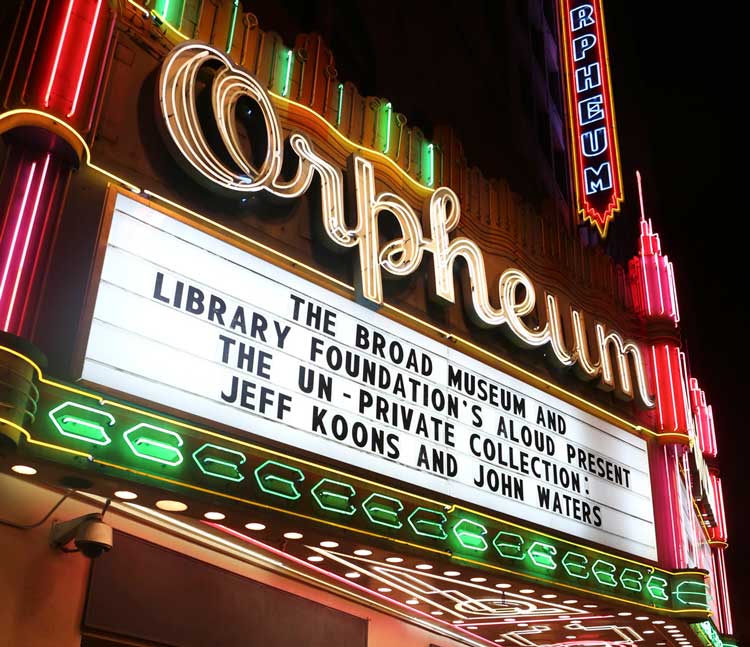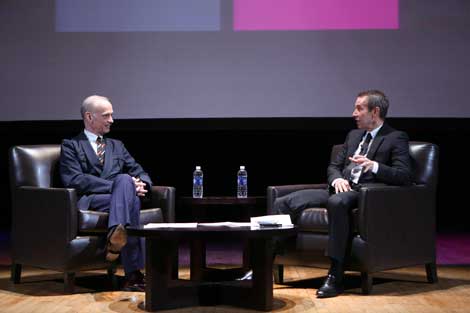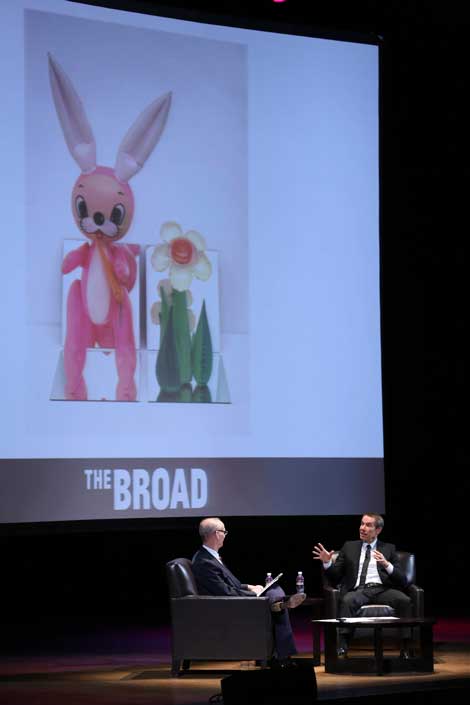Setting aside the uninflected kitsch of so much of Jeff Koons’ work which (however recontextualized) can be more than a little nauseating, what often seems frustrating is simply its wholesale evasion of considerations of taste and judgment. As we might expect from the director of Pink Flamingos and Desperate Living, John Waters knows to go straight to the poison, the nauseating agents themselves. As such, he made both a perfect judge and advocate for Koons. What was billed as a ‘conversation,’ “The Un-Private Collection”– under the auspices of the Library Foundation’s Aloud series and the Broad Museum – was really more like a three-way arbitration between Koons, Eli and Edye Broad, their Foundation and unfinished Museum, and the rest of us.
Although Waters’ ‘witness’ remained frustratingly, almost recalcitrantly opaque and obtuse, Waters was penetrating and frequently brilliant in his art historian/advocate guise. It was a performance both Gerry Spence and Lord Kenneth Clark might have envied. I don’t think I’ve seen the likes of it since Senator Dale Bumpers gave his closing statement in the defense against Bill Clinton’s presidential impeachment.
After the Library Foundation president, Ken Brecher’s, and Broad Museum director, Joanne Heyler’s unctuous introductions, Waters dove right into “Freudian” “secret art life” questions. Koons made his early art experiences sound as innocuous as soccer and high school marching band, but Waters pressed. “Did you ever draw anything that caused alarm?” Koons’ response – that art could hold interest without “creating anxiety” – would prove revealing. Waters confessed that he reveled in the anxieties his early art interests elicited among his high school friends – “the power of art.”
However unsophisticated Koons may or may not have been, his ambitions and confidence showed early. Referring to his earliest museum and art history encounters with Cezanne and Matisse (and Manet), he said, “I survived that moment.” He was also secure in his tastes, or if you will, ‘feelings.’ Included among his touchstone ‘art’ experiences were return encounters at his grandparents’ house with a porcelain ashtray in the shape of a recumbent woman’s figure, the legs of which parted as a cigarette’s ashes were tapped into it or the cigarette was extinguished. “That work is as wonderful as the (Michelangelo) Pietà.” As focused as he was, that focus shifted at some point while he was studying with the Chicago Imagists. “I wanted to stop making subjective work.”
Throughout the conversation, Koons was almost infuriatingly vague. By his telling, the affective range of his work might just as well be nil. “Optimistic… like feeling a vast and exciting sense of future.” These terms came up again and again. He was willing to admit the “Inflatables” weren’t entirely innocent. A rabbit’s carrot might evoke “masturbation.” Waters tried to tease out some expression of taste or judgment – “Is it cute? Is it threatening?” Waters brought the “Caterpillar and Ladder” up on screen. Childhood was looking a little dangerous. That was about “going through things in life and staying on course.” Hmm… And the little hippo and big turtle on the cyclone fence? Waters suggested a caption. “You don’t know if it’s a playroom or a prison…. It’s a joyless place,” he said joyfully. The balance between ‘masculine’ (in Koons-speak, anything that projected in space) and feminine (the pneumatic, or penetrable) is another recurring preoccupation. The balloon dog tails had a “male energy.”
“But,” Waters jumped in, “it’s cleaned up. It’s neutered.”
Koons studied the iconic dog anew. “The legs are really quite feminine.”
History was also evoked by the gilded porcelain “Michael Jackson and Bubbles” sculpture. “It’s like the pyramids of Giza,” Koons said; and of course, “the Pietà.”
Waters tried to discreetly, respectfully, probe the Koons aura – there was no chance of penetrating it – as well as the patina of the Koons product. “You are a brand…. Do you think people can look at your work fresh?” And not surprisingly, there was a bit of contradiction in both the person and the product. Koons wants always to “make the work accessible.” Yet, inexplicably, “I wanted to participate in the avant-garde.” (As in the “New” series – Koons homage to the readymade?) Then, returning to his nostrums – “Acceptance is not making judgments.”
Waters clearly respects Koons, isn’t fazed by his manifest cynicism, and admires some (though not all) of his work. Also – he wasn’t finished: he had plenty of rope to pay out before this deposition was over. So I’ll just say it here. Koons’ answers were fucking lame.
As “acceptance” and “working small” goes, you can’t get much more accepting than a gazing ball. (I’m also wondering just how far he can go with something quite this generic.) Needless to say, some of the iterations in this series have been rather pretentious, even grandiose – e.g., a blue gazing ball affixed to the shoulder of an appropriated Farnese Hercules, which Waters pulled up on the screen. (And Lady Gaga has famously used one on her ArtPop album.)
Waters is self-avowedly not one to leave a rock unturned or a piece of junk uninvestigated, and I shouldn’t have been surprised that some of his gentle queries turned up some blood diamonds. Consider, for example, regarding:
Koons’ depersonalized factory style of production: “I’m afraid of being too physically involved.”
Koons’ career as a commodities trader went largely unexamined but: “Sales is the front line of morality.”
The pressure for Koons to top himself: “No, [but rather] another opportunity to exercise freedom.”
Any darkness at all amid all this optimism? “The deeper you go, the darker it gets…. They’re all death.”
“Life happens to us. Art happens in us.”
“We all benefit by experiencing transcendence.”
The evening closed with a few pre-solicited (and vetted) questions from some members of the audience (but not the press). But Koons’ choices for “favorite writers” was interesting – particularly in light of his remarks regarding anxiety in art (but not – at least intentionally – in his own): Plato (of course) and Søren Kierkegaard – as in Fear and Trembling and the Sickness Unto Death. Ya think it gets any darker than that? Refresh your reading of The Republic; go see The Croods (or just read Koons’ fulsome e-mail – later used as a full-page ad for the film in The New York Times); oh – and consider his personal carbon footprint(!); and tuck into bed with a little Kierkegaard. It’s not exactly a vision ‘made in heaven.’
All images © Ryan Miller/The Broad






